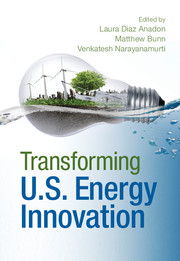Book contents
- Frontmatter
- Contents
- 1 The Need to Transform U.S. Energy Innovation
- 2 Expanding and Better Targeting U.S. Investment in Energy Innovation: An Analytical Approach
- 3 Reforming U.S. Energy Innovation Institutions: Maximizing the Return on Investment
- 4 Encouraging Private Sector Energy Technology Innovation and Public–Private Cooperation
- 5 Maximizing the Benefit from International Cooperation in Energy Innovation
- 6 Transforming U.S. Energy Innovation: How Do We Get There?
- Index
- References
2 - Expanding and Better Targeting U.S. Investment in Energy Innovation: An Analytical Approach
Published online by Cambridge University Press: 05 August 2014
- Frontmatter
- Contents
- 1 The Need to Transform U.S. Energy Innovation
- 2 Expanding and Better Targeting U.S. Investment in Energy Innovation: An Analytical Approach
- 3 Reforming U.S. Energy Innovation Institutions: Maximizing the Return on Investment
- 4 Encouraging Private Sector Energy Technology Innovation and Public–Private Cooperation
- 5 Maximizing the Benefit from International Cooperation in Energy Innovation
- 6 Transforming U.S. Energy Innovation: How Do We Get There?
- Index
- References
Summary
In Chapter 1 we describe the urgent challenges posed by the current U.S. energy system and make the case that accelerated innovation in energy technologies will be essential in meeting these challenges. In this chapter, we explore the question of determining the appropriate role for the U.S. government in fostering energy innovation. This is a complex issue because the U.S. energy system encompasses many functions (e.g., invention and discovery, R&D spillovers, economies of scale, clustering, learning by doing, deployment, etc.); government actions to facilitate innovation interact with private actors in many markets; there are a multiplicity of actors (e.g., national and regional public organizations, private firms, universities, consumers); there is deep uncertainty in future technology performance rooted in many factors (e.g., the rate of technological change, economic growth, energy prices, consumer adoption, etc.).
In this book we take a systems approach to the innovation process. The chapter starts by focusing on selected key government functions, and in Chapter 6, we integrate the analysis from this chapter with analysis and holistic recommendations that cut across the entire system. Our analysis in this chapter starts with the energy research, development, and demonstration (RD&D) investments of the U.S. Department of Energy (DOE) – the single largest public funder of energy RD&D in the United States. Despite the broader scope of DOE's jurisdiction, which we trace to its historical roots, we limit our analysis to only the department's energy RD&D funding activities. After describing DOE's current role investing in energy RD&D, we analyze how DOE makes decisions about its energy RD&D investments. We argue that a method to inform public energy RD&D funding decisions that allows for an integrated, consistent, and transparent analysis among competing technology areas is needed.
Information
- Type
- Chapter
- Information
- Transforming US Energy Innovation , pp. 36 - 80Publisher: Cambridge University PressPrint publication year: 2014
References
Accessibility standard: Unknown
Why this information is here
This section outlines the accessibility features of this content - including support for screen readers, full keyboard navigation and high-contrast display options. This may not be relevant for you.Accessibility Information
- 7
- Cited by
